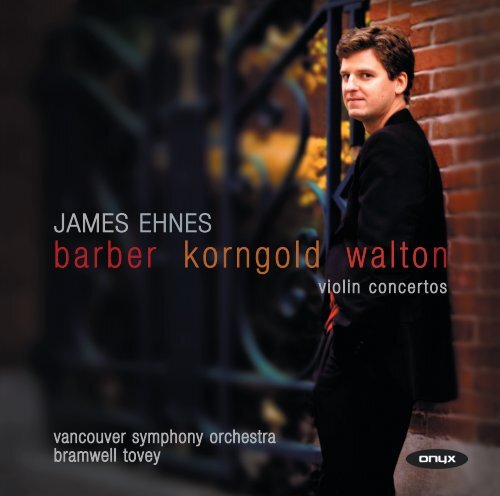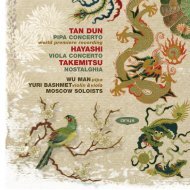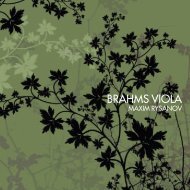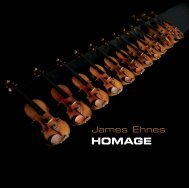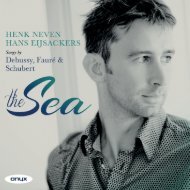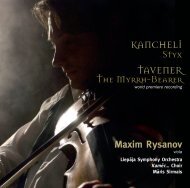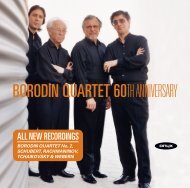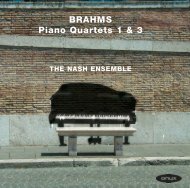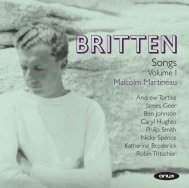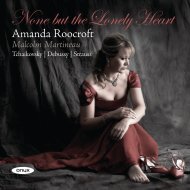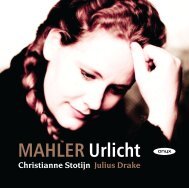Untitled - Onyx Classics
Untitled - Onyx Classics
Untitled - Onyx Classics
Create successful ePaper yourself
Turn your PDF publications into a flip-book with our unique Google optimized e-Paper software.
“More corn than gold,” was the cruel put-down of the American critic Irving Kolodin after hearing thepremière of the opulent Violin Concerto by Erich Wolfgang Korngold (1897–1957), played by JaschaHeifetz. Korngold was 50 and his life had already mirrored some of the major political and socialupheavals of the 20th century. “Fifty is old for a child prodigy,” he said, wryly looking back on theunpredictable and, to him, ultimately unsatisfying course that his life and music had taken.Success came early. At 10, Mahler declared the child prodigy a genius. The middle name of Wolfgang,bestowed by a pushy, over-protective father, seemed inevitable at the time, forward-looking ratherthan presumptuous. The Vienna Court Opera presented Korngold’s precocious pantomime DerSchneeman (The Snowman), written when he was eleven. Operas and symphonic works flowed fromhis pen before he was twenty. His music was taken up by the likes of Kreisler and Flesch, Schnabel andCortot, Tauber and Lehman, Weingartner and Walter. It was crowned by Die tote Stadt (1916–20),which became one of the most performed operas of the 1920s, reaching more than 80 stagesworldwide. Korngold’s success was defined by his operas and his operatic writing came to define hisown musical style.In 1934, with Europe increasingly becoming a dangerous place for a Jewish composer, Korngold wasdrawn to Hollywood. “I never drew a distinction between music for films and for operas or concerts,”he said. A favourable contract with Warner Bros. followed and for the next twelve years Korngoldcomposed seventeen major film scores, including two Academy Award winners. Now, Korngold’scommand of the late romantic musical vocabulary and his fluency in underscoring dramatic narrativeblossomed from the stage into a medium that reached millions. Nostalgia, fantasy and escape werekey ingredients of the Hollywood movies of the 1930s and 1940s and Korngold’s music captured themood of the times to an extraordinary degree. Perceptively, Korngold had negotiated to keep his owncopyright in his music written for Hollywood — and this was to prove crucial when he came to writethe Violin Concerto.From the last of his film scores, Deception (1946), starring his favourite actress, Bette Davis, Korngoldextracted his Cello Concerto. It was concert music of a sort he had consciously ignored while exiledfrom Vienna. His Violin Concerto, too, turned inward to the lush melodies and plush orchestrations heknew so well from his work in the studios. It opens with a glorious melody that captures the very soulof the violin itself. It is borrowed from the music he wrote for the film Another Dawn (1937). Thesecond theme is no less lyrical and nostalgic, drawn this time from the historical epic Juarez (1939).The sweetly singing violin line was a good fit for the work’s earliest champion, Heifetz, who gave the
The first chord speaks volumes. After a piano roll, soloist and orchestra enter together; there is to beno contest between the two, no heroic soloist pitted against the orchestra. The chord is G major; theconcerto is anchored in tonality throughout. The violin takes up a wonderfully lyrical melody; therewill be dynamic contrast later in the movement, but tranquillity is the pervading emotion. TheAndante opens with another glorious, heart-warming melody, this time on the oboe. Barber lets theoboe, then strings and horn, enjoy its contours before re-introducing the solo violin. Even then, thesoloist presents different, more rhapsodic material, only savouring the main theme later on, low onthe G-string. The finale is a non-stop, tour de force for the soloist, exciting and visceral, with fastrunningtriplets. Its harmonies have an edge that is less obvious in the softer, smoother harmonies ofthe first two movements. Albert Spalding was chosen to give the première. “He’s no Heifetz — but weshall see,” Barber said at the time. After its first performance in Philadelphia in 1941, both the criticsand audience acclaimed the concerto. But few violinists played the piece. It was only in the CD erathat violinists have taken up the work, making it now one of the most played of all violin concertos.Like Erich Korngold, the English composer William Walton (1902–1983) composed music for both theconcert hall and film studio. Neither composer fully resolved the conflicts the two worlds to his ownsatisfaction. As he began work on his Violin Concerto, the 36-year-old William Turner Walton wrote:“It all boils down to this: whether I am to become a film composer or a real composer.” Thecommission to write the concerto had come from Heifetz two years earlier, in 1936. Film scores andother projects delayed the start of work on the concerto. Walton’s reputation was growing on anumber of fronts. His witty, spiky, jazz-coloured music for Façade had given him an instant reputationas one of the few enfants terribles among English composers. Walton was seen as non-parochial, intouch with musical trends in continental Europe and unlikely to get his boots dirty walking throughthe English countryside in search of folksongs. His oratorio Belshazzar’s Feast and the First Symphonyenhanced a reputation for pouring an entirely new vintage of wine into traditional bottles. His 1937coronation march Crown Imperial, on the other hand, reassured his fellow-countrymen that althoughWalton had already demonstrated an alarming tendency to flee British winters in favour of thewarmth of Italy, he could still turn out a good British march for state occasions.Today, a little over a century after his birth in working-class Oldham, Walton is recognised as the mostimportant British composer between Vaughan Williams and Britten. Walton himself, however, wasconstantly racked by doubt. “The trouble is, I wasn’t properly trained,” he used to say, thinking of howhe had escaped his northern background by winning a scholarship to choir school in Oxford, faileduniversity and been taken up first by the Sitwells (Osbert, Edith and Sacheverell) and then by a
succession of beautiful, wealthy women. The Violin Concerto was written under the inspiration of oneof them. She was Viscountess Wimbourne — “beautiful, intelligent Alice” — who had rented the idyllicVilla Cimbrone for the two of them above Ravello, overlooking the Mediterranean. The concerto’slyricism shimmers with Mediterranean warmth. But its musical structure, painstakingly worked out, isborn from a sharp mind and pragmatic intellect.Its opening melody is radiant and lyrical and is one of the longest and most convincing melodiesWalton ever created. Played sognando (dreamily), it soars gloriously high. It is underpinned by acounter-theme on cellos with bassoon and clarinet that is rich in thematic possibilities. While writingthe concerto, Walton worried that his dreamy romantic opening was to be the work’s downfall. Butthe gentle opening helps to establish one extreme of the contrast that characterises the work. Theother extreme comes with the angular, rhythmic brass chords that announce the development. Here,the violin first puts the opening themes through virtuoso display then, after a brief cadenza, dwellsmore reflectively on the lyrical second theme. A surprise is in store as the flute takes the main melodywhen it reappears, while the violin presents the counter-melody.If a tarantula can bite me, Walton seems to say at the start of the second movement, then I can bite back!He was, in fact, bitten while at work on the concerto and a tarantella-like dance opens the Prestocapriccioso alla napolitana. Urged on by Heifetz to make it difficult, Walton throws in a storm ofirregular accented triplets and constant changes of dynamics, bow-strokes and specific notes within asequence. “It’s quite gaga, I must say,” Walton wrote to his publisher, “and of doubtful propriety after thefirst movement.” A seductively slithering waltz theme captures Heifetz’s insolent way with doublestops.A horn solo introduces a contrast of mood in the canzonetta trio section. Then it’s back to thespider’s venom until the finale opens with a brusque, marching theme on the lower strings and bassoons.The violin is quick to pounce on this theme and twist it into something more angular. The second theme,however, again revisits Walton’s romantic core, but doesn’t linger long in the Mediterranean sun. Thetwo themes are developed as Walton increases the overall momentum and tension of the concerto toput the balance of weight here in the finale. After the opening theme has been revisited, there’s one ofthe loveliest, most unbuttoned moments in the concerto as Walton floats in a double-stopped echo ofthe radiant opening theme from the first movement. It leads straight to the sunny theme from the finaleand to a glittering accompanied cadenza where all three themes are reviewed. This is where Walton payshomage to that other great B minor English violin concerto, that of Elgar. As there, Walton writes thedirection sognando over his dreamy, reflective music before a final flourish brings us back to the present.© Keith Horner 2006
“More corn than gold”. C’est par ce jeu de mots intraduisible sur le nom du compositeur que lecritique américain Irving Kolodin exprima son cruel verdict après avoir assisté à la création, par JaschaHeifetz, de l’opulent Concerto pour violon d’Erich Wolfgang Korngold (1897–1957). Âgé alors decinquante ans, le compositeur avait déjà traversé plusieurs des bouleversements politiques et sociauxqui ont marqué le XX e siècle. “Cinquante ans, c’est vieux pour un enfant prodige”, ironisait-il en jetantun coup d’œil rétrospectif sur le cours plutôt imprévisible que sa vie et sa musique avaient pris et qu’iltrouvait, en définitive, peu satisfaisant.En effet, il avait connu le succès très jeune. À dix ans, Mahler le considérait comme un génie. Sondeuxième prénom, Wolfgang, qui lui avait été octroyé par un père ambitieux et excessivementprotecteur de son fils, semblait normal à l’époque, prémonitoire plutôt que présomptueux. L’Opérade la cour de Vienne représenta Der Schneeman (Le Bonhomme de neige), pantomime que le jeuneKorngold avait écrite à l’âge de onze ans. Avant d’avoir atteint sa vingtième année, opéras et œuvressymphoniques semblaient couler tout seuls de sa plume. Sa musique fut acceptée par des musiciensdu calibre de Kreisler et Flesch, Schnabel et Cortot, Tauber et Lehman, Weingartner et Walter. Lecouronnement de ses œuvres fut l’opéra Die tote Stadt (1916–1920), l’un des opéras les plus joués desannées 1920, époque où il fut représenté sur plus de quatre-vingts scènes du monde entier. Korngolddevait son succès à ses opéras, et c’est son écriture pour l’opéra qui allait définir son style musicalpropre.En 1934, vivre en Europe devenant de plus en plus dangereux pour un compositeur juif, Korngold estattiré par Hollywood. “Je n’ai jamais fait la distinction entre la musique pour films et celle pour lesopéras et les concerts”, devait-il dire. Il décroche un contrat lucratif avec Warner Bros et, pendantdouze ans, Korngold composa la musique pour dix-sept grands films, y compris deux pour lesquels ilremporta un Oscar. Grâce à sa maîtrise du vocabulaire musical de la fin de l’ère romantique et à sacapacité à souligner les situations dramatiques, Korngold quittera désormais la scène pour le cinéma,ce qui lui permet d’atteindre un public se chiffrant par millions. La nostalgie, la fantaisie et l’évasionétaient les ingrédients clés des films d’Hollywood dans les années trente et quarante, et la musique deKorngold savait capter l’ambiance de cette période à un degré extraordinaire. Avec beaucoup deperspicacité, Korngold avait négocié son propre droit d’auteur sur la musique qu’il avait écrite pourHollywood — ce qui s’avère être un atout crucial lorsqu’il se met à écrire le Concerto pour violon.En effet, c’est de la musique de son dernier film, Deception (1946), dont la vedette était son actricepréférée, Bette Davis, que Korngold put extraire son Concerto pour violoncelle. C’est une musique de
concert d’un genre qu’il avait consciemment ignoré depuis son exil de Vienne. Son Concerto pourviolon est aussi un exercice d’introspection sur les riches mélodies et les orchestrations somptueusesqu’il connaissait si bien du fait de son travail dans les studios. Il ouvre sur une mélodie superbe quicapte l’âme même du violon, une mélodie empruntée à la musique qu’il avait écrite pour le filmAnother Dawn (1937). Le deuxième thème, qui n’est pas moins lyrique et nostalgique, est tiré cette foisdu film-épopée historique Juarez (1939). Le doux chant du violon convenait à merveille à Heifetz, quise fit le champion de l’œuvre dont il avait assuré la création en 1947 et dont il fit un enregistrementrenommé quelques années plus tard. Le violoniste polonais Bronisl aw Huberman avait fréquemment/encouragé Korngold à achever le concerto après en avoir vu la première esquisse en 1937, mais aumoment où l’œuvre était terminée, il était reparti pour l’Europe.La Romance reprend, sur un ton rêveur, le thème principal d’une des musiques de films de Korngoldqui ont remporté un Oscar, Anthony Adverse (1936), un film triste et sentimental qui se déroulait enItalie au XVIII e siècle. Ses méditations extasiées jouées sur la corde supérieure de mi sontsomptueusement soulignées par un accompagnement d’orchestre chatoyant, mais sombre. Korngolddit un jour que ce concerto était écrit “pour un Caruso, plutôt que pour un Paganini”. Le Finaleprésente des variations exigeant une grande virtuosité sur un theme d’une des plus belles musiques defilms de Korngold, le classique The Prince and the Pauper (1937), basé sur un roman de Mark Twain. Àune vitesse vertigineuse, il s’achemine vers une coda époustouflante qui marque l’apogée de l’œuvre.Le compositeur américain Samuel Barber (1910–1981) appelait son Concerto pour violon sonconcerto da sapone, son “concerto savon”. Et plus d’une fois il a dû souhaiter pouvoir oublier lescirconstances qui ont entouré la commande de cette œuvre. Le mécène qui lui avait offert son cachetétait Samuel Fels, le riche fabricant du savon Fels Naptha. M. Fels était également membre du conseild’administration du Curtis Institute of Music. Le violoniste désigné était Iso Briselli, son fils adoptif ethéritier. M. Fels avait été bien inspiré lorsqu’il s’adressa à Samuel Barber. Peu connu, le compositeurn’avait encore décroché aucune commande importante, mais sa musique avait suscité de l’intérêtl’année précédente, en 1938, lorsqueToscanini avait dirigé la création et la radiodiffusion de son Adagiopour cordes. M. Fels offrit 1.000 dollars, une grosse somme pour un compositeur jeune et inconnu.Samuel Barber achève les deux premiers mouvements pendant l’été 1939 en Suisse. Il se trouvait auFestival de Lucerne, conçu comme étant le pendant anti-nazi de Salzbourg, avec son compagnon GianCarlo Menotti et plusieurs musiciens de haut vol. Quelques mois plus tard, il commence le finale àParis. Mais par suite de l’invasion imminente de la Pologne par les nazis, tous les Américains sont
encouragés à quitter l’Europe. On l’aide à obtenir un billet de passage, et Samuel Barber fait latraversée sur le Champlain. Son acompte de 500 dollars est donc dépensé. Entre temps, Briselli a jugéque les deux premiers mouvements de l’œuvre étaient “trop simples et pas assez brillants pour unconcerto ”. Mais lorsque Barber lui présente une esquisse de son brillant finale, Briselli déclare qu’il esttrop difficile à jouer.On convoque rapidement un comité au Curtis Institute. Le choix se rabat sur un étudiant du violonassis dans la salle commune. On lui remet une esquisse au crayon d’une partie du finale, on lui donnedeux heures pour l’apprendre en lui disant de “le jouer vite ” et de revenir “en tenue de soirée ”, prêt àl’interpréter devant quelques personnages importants. Cette exécution improvisée a lieu au studio dugrand pianiste Josef Hofmann. Il y eut des bravos, on servit le thé et des biscuits, Briselli perdit sesdroits sur la création et Barber finit par recevoir les 500 dollars qui lui étaient encore dus.D’entrée de jeu, les premiers accords déjà en disent long. Après une roulade du piano, le soliste etl’orchestre commencent ensemble, sans aucun esprit d’affrontement, car le soliste n’est pas un hérosqui jouerait contre l’orchestre. L’accord est en sol majeur; le concerto tout entier est ancré dans latonalité. Le violon continue sur une mélodie merveilleusement lyrique; quant au contrastedynamique, on le trouvera plus tard dans le mouvement, mais l’impression générale qui s’en dégageest un sentiment de calme. L’Andante ouvre sur une autre mélodie superbe et chaleureuse, jouéecette fois par le hautbois. Barber laisse au hautbois, puis aux cordes et au cor, le soin d’en tracer lescontours avant de réintroduire le violon solo. Même là, le soliste présente une musique différente,plus rhapsodique, quitte à s’attarder sur le thème principal plus tard, joué sur la corde inférieure desol. Le finale est, pour le soliste, un véritable tour de force, persistant, excitant et viscéral, avec destriolets en succession rapide. Ses harmonies ont un côté cinglant, qui est moins évident dans lesharmonies plus douces des deux premiers mouvements. C’est Albert Spalding qui est choisi pourinterpréter l’œuvre lors de sa création. “ Il n’est pas un Heifetz — mais nous allons voir ”, avait ditBarber. Après la création à Philadelphie en 1941, la critique tout comme le public acclament leconcerto. Mais peu de violonistes jouent celui-ci. Ce n’est qu’après l’avènement du disque compactque les violonistes s’attaqueront à cette œuvre, qui est devenue aujourd’hui l’un des concertos pourviolon les plus joués.Tout comme Erich Korngold, le compositeur anglais William Walton (1902–1983) composait de lamusique destinée aussi bien à la salle de concert qu’aux studios de cinéma. Ni l’un ni l’autre ne réussità résoudre de façon entièrement satisfaisante les conflits que représentaient pour eux ces deux
mondes. Lorsqu’il commence à travailler à son Concerto pour violon, William Turner Walton, alorsâgé de trente ans, écrit ceci : “En somme, il s’agit de savoir si je dois devenir un compositeur demusique de films ou un vrai compositeur.” La commande lui avait été passée par Heifetz deux ansauparavant, en 1936, mais plusieurs musiques de films et autres projets retarderont le commencementdu travail sur le concerto. La réputation de Walton grandissait dans plusieurs domaines. Sa musiquepour Façade, spirituelle, hérissée et teintée de jazz, lui avait valu instantanément la notoriété d’un desenfants terribles parmi les compositeurs anglais. On voyait en Walton un musicien libéré del’étroitesse d’esprit générale, en contact avec les tendances de l’Europe continentale en matière demusique et peu enclin à se salir les bottes à parcourir la campagne anglaise en quête de chantsfolkloriques. Son oratorio Belshazzar’s Feast et sa Première Symphonie rehaussent sa réputation decompositeur prêt à verser du vin d’une nouvelle cuvée dans les bouteilles traditionnelles. Par ailleurs,sa marche du couronnement intitulée Crown Imperial, composée en 1937, rassure ses compatriotes enleur démontrant que, si Walton avait déjà manifesté une fâcheuse tendance à fuir les hiversbritanniques pour les cieux plus cléments de l’Italie, il pouvait néanmoins encore composer unemarche bien britannique pour une occasion officielle.Aujourd’hui, il y a un peu plus d’un siècle depuis sa naissance dans la ville ouvrière d’Oldham, etWalton est reconnu comme le compositeur britannique le plus important entre Vaughan Williams etBritten. Cependant, Walton lui-même était sans cesse assailli de doutes. “L’ennui, c’est que je n’ai pasreçu la formation qu’il aurait fallu”, disait-il, songeant qu’il avait échappé à une vie dans le nord del’Angleterre en gagnant une bourse pour une école de chœur d’Oxford ; après avoir échoué dans sesétudes universitaires, il fut recueilli d’abord par les Sitwell (Osbert, Edith et Sacheverell), puis par unesuccession de femmes belles et riches. Le Concerto pour violon fut écrit sous l’inspiration de l’une deces femmes, la vicomtesse Wimbourne — “la belle et intelligente Alice” — qui avait loué pour Waltonet elle l’idyllique villa Cimbrone située au-dessus de Ravello, avec vue sur la Méditerranée. Le lyrismedu concerto reflète le scintillement du chaud climat méditerranéen. Mais sa structure musicale,méticuleusement travaillée, est le fruit d’un esprit vif et d’une intelligence pragmatique.Sa mélodie d’ouverture, radieuse et lyrique, est l’une des plus longues et des plus convaincantes queWalton ait jamais créées. Jouée en sognando (rêveur), elle s’élance vers les cimes les plus élevées. Elleest étayée par un contre-thème joué par les violoncelles, avec le basson et la clarinette, et riche enpossibilités thématiques. Pendant la composition de ce concerto, Walton s’inquiétait à l’idée que sonouverture songeuse et romantique ferait échouer l’œuvre. Mais cette ouverture si tendre contribue àdéfinir un des extrêmes du contraste qui caractérise celle-ci. On atteint l’autre extrême avec les
accords rythmiques et anguleux des accords des cuivres qui annoncent le développement. Là, leviolon présente les thèmes d’ouverture d’une façon exigeant une grande virtuosité. Puis, après unebrève cadence, il s’attarde de manière plus pensive sur le deuxième thème lyrique. Le compositeurnous réserve une surprise lorsque la flûte reprend la mélodie principale lors de sa réapparîtion, alorsque le violon présente la contre-mélodie.Si une tarentule peut me mordre, semble dire Walton au début du deuxième mouvement, alors jepeux la mordre à mon tour ! De fait, il a été mordu par un de ces insectes pendant la composition duconcerto, et c’est une danse du genre tarentelle qui ouvre le Presto capriccioso alla napolitana.Heifetz l’ayant encouragé à rendre ce mouvement difficile, Walton nous soumet à une rafale detriolets irrégulièrement accentués et, au sein d’une même séquence, à des changements constants dela dynamique, des coups d’archet et de notes spécifiques. “J’avoue que c’est plutôt gaga”, écrivaitWalton à son éditeur, “et d’un à-propos douteux après le premier mouvement”. Un thème de valseséducteur et onduleux capte l’insolence avec laquelle Heifetz traite les doubles cordes. Un solo decor introduit une ambiance contrastante dans la canzonetta, la section en trio. Ensuite, nous revenonsau venin de l’araignée jusqu’à ce que le finale ouvre sur un thème de marche abrupt interprété par lescordes inférieures et les bassons. Le violon est prompt à s’emparer de ce thème et à le tordre pour enfaire quelque chose de plus anguleux. Le deuxième thème, en revanche, retrouve le cœur romantiquede Walton, mais ne se prélasse pas longtemps au soleil de la Méditerranée. Le compositeur développeles deux thèmes, tout en intensifiant l’élan et la tension d’ensemble du concerto pour rétablirl’équilibre dans le finale. Après la reprise du thème d’ouverture, nous assistons à l’un des moments lesplus ravissants, les plus décontractés du concerto, où Walton flotte dans un écho sur doubles cordesle radieux thème d’ouverture du premier mouvement. Il nous mène droit vers le thème ensoleillé dufinale et dans une cadence scintillante non accompagnée où tous les thèmes sont passés en revue.C’est là que le Concerto pour violon de Walton rend hommage à cet autre grand concerto anglais pourviolon en si mineur, celui d’Elgar. Tout comme ce dernier, Walton fait précéder sa musique rêveuse etpensive du titre sognando avant qu’un dernier éclat nous ramène carrément au temps présent.Keith Horner 2006Traduction: Charles Metz
“One of the most gifted and sincerely expressive artists to have emerged in recent times”(The Daily Telegraph), James Ehnes has established an international career of rare distinction.James Ehnes has performed in over twenty countries on four continents with such renownedconductors as Vladimir Ashkenazy, Sir Andrew Davis, Charles Dutoit, Iván Fischer, Richard Hickox,Paavo Järvi, Lorin Maazel, Sir Charles Mackerras, Stanisl aw Skrowaczewski and Christian Thielemann./Performances in Europe have included appearances with the London Symphony Orchestra, thePhilharmonia, the BBC Symphony Orchestra, the BBC Philharmonic, the Royal Scottish NationalOrchestra, the Scottish Chamber Orchestra, the DSO Berlin, the Deutsche Kammerphilharmonie, theOrchestre de Lyon, the Czech Philharmonic, the Budapest Festival Orchestra and the Finnish RadioSymphony Orchestra. He has appeared in Asia with the NHK Symphony Orchestra (Tokyo), the HongKong Philharmonic and the Malaysian Philharmonic, and in North America with every major orchestra— New York, Boston, Chicago, Cleveland, Philadelphia, Los Angeles, San Francisco, Pittsburgh,Cincinnati, Detroit, Minnesota, St Paul, Houston, Dallas, Seattle, Vancouver, Calgary, Winnipeg,Ottawa, Toronto, and Montréal.Recitals have taken Mr Ehnes to major cities around the world including London, Paris, Geneva,Prague, Tokyo, Osaka, Chicago, Washington, DC, Toronto, Montréal, and Vancouver. He has alsoperformed at major international festivals including the Ravinia Festival, the Marlboro Festival, theSeattle Chamber Music Festival, the Tokyo Summer Music Festival and the White Nights Festival.A prolific recording artist, James Ehnes has recorded repertoire ranging from Bach violin sonatas toJohn Adams’s Road Movies. His CBC recordings with the Orchestre symphonique de Montréal of MaxBruch’s Concertos 1 and 3 (with Charles Dutoit) and Concerto No. 2 with the Scottish Fantasy (withMario Bernardi) won back-to-back Juno awards in 2002 and 2003 for Best Classical Recording.Born in Brandon, Manitoba, Canada in 1976, he began violin studies at the age of four, and at ninebecame a protégé of the noted Canadian violinist Francis Chaplin. He continued his studies with SallyThomas at The Juilliard School, winning the Peter Mennin Prize for Outstanding Achievement andLeadership in Music upon his graduation in 1997.James Ehnes plays the “Ex Marsick” Stradivarius of 1715 and gratefully acknowledges its extended loanfrom the Fulton Collection.www.jamesehnes.com
English by birth, Bramwell Tovey joined the Vancouver Symphony Orchestra as Music Director inSeptember 2000. From 2002 to 2006, he was also music director of the Orchestre Philharmonique duLuxembourg. During this time, he toured with the orchestra throughout Europe, the USA and the FarEast, and gave the world premiere of Penderecki's Eighth Symphony at the opening of Luxembourg’snew Philharmonic Hall in 2005.Tovey made his New York Philharmonic subscription debut in 2001 and since 2004 has led theorchestra’s annual Summertime <strong>Classics</strong> festival at Lincoln Center. Future engagements include theLos Angeles Philharmonic (at both the Hollywood Bowl and Walt Disney Hall), the Seattle, Detroit,Quebec and Toronto symphony orchestras and the New York and Royal Philharmonic orchestras.From 1989 to 2001, Bramwell Tovey was Artistic Director of the Winnipeg Symphony and prior to thatPrincipal Conductor of the Sadler’s Wells Royal Ballet in London. As a composer he won the 2003 JunoAward for Best Classical Composition for his Requiem for a Charred Skull. He has also writtenconcertos for cello and viola and is currently working on an opera. He holds honorary doctorates fromthe Universities of Manitoba and Winnipeg, is a Fellow of the Royal Academy of Music in London andin 2005 was appointed a Fellow of the Royal Conservatory of Music in Toronto.Founded in 1919, the Vancouver Symphony Orchestra (VSO) is in the top echelon of Canadianorchestras, and previous music directors have included Meredith Davies, Rudolf Barshai and SergiuComissiona, while guest conductors have included Barbirolli, Beecham, Bernstein, Dorati andKlemperer. It features more than fifty guest artists each season in more than 140 concerts. Innovatorsin the orchestral community, the 2003/04 season saw the VSO breaking new ground by becoming thefirst orchestra in Canada to use video screens in a full classical concert series. Leading up to theVancouver 2010 Olympics, the VSO will present over twenty-five premieres of short commissions byyoung Canadian composers. Upcoming seasons feature performances from a stellar line-up of soloistsincluding Renée Fleming, Yundi Li, Marc-André Hamelin, Stephen Hough, Jean-Yves Thibaudet andJames Ehnes, returning with the Barber concerto under the orchestra’s present Music Director,Bramwell Tovey.
Project Manager: Randy BarnardONYX Project Manager: Paul MoseleyRecording and Project Producer: Denise BallRecording Engineer and Digital Editing: Don HarderTechnical Assistant: Bruce DierickRecorded: Orpheum Theatre, Vancouver, 22–23 February 2006 (Korngold); 6–7 June 2006 (Barber & Walton)Graphic Design: Megan RossCover Photos: Anna Keenan 2005Special thanks to Moira Johnson ConsultingCBC Records P & g 2006 Canadian Broadcasting Corporation under exclusive licence to PM<strong>Classics</strong> Ltdwww.cbcrecords.cawww.onyxclassics.com
www.onyxclassics.com ONYX 4016


